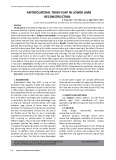
44
Journal of Medicine and Pharmacy, Volume 9, No.3/2019
ANTEROLATERAL THIGH FLAP IN LOWER LIMB
RECONSTRUCTION
Le Hong Phuc1, Tran Thiet Son2, Le Nghi Thanh Nhan1
(1) Hue University of Medicine and Pharmacy, Hue University; (2) Hanoi Medical University
Abstract
Introduction: Anterolateral thigh flap is one of the most researched and widely used perforator flaps in
the recent decades in plastic surgery as a whole and in limb reconstruction, especially in cases with complex
deflects, in particular. This report aimed to evaluate anterolateral thigh flap in reconstruction of complex
lower limb soft tissue defects. Subjects and methods: From August 2014 to August 2015, at Hue University of
Medicine and Pharmacy Hospital, 12 cases with complex soft tissue defects in lower limb were reconstructed
and covered with ALT flaps: two distal based pedicle ALT flaps for popliteal and around knee joint defects and
10 composite ALT free flaps for lower leg reconstruction. Results: Twelve flaps used included: two peripheral
pedicled fasciocutaneous flaps, ten complex free flaps (01 complex myo-fasciocutaneous flap providing
muscle for deep space filled, fascial for tendon reconstruction and surface covering of the defect; 05 vastus
lareralis myocutaneous flaps providing muscle for dead space filling and covering; 04 fasciocutaneous flaps
involving the fascia lata for fascial reconstruction and covering). The size of flaps ranged from 8 to 27cm
in length and from 6 to 13cm in width. The largest flap was 240cm2,the smallest was 50cm2. All 12 flaps
survived. Short-term results at one month after surgery were consideredas good in eleven patients and fair
in one patient. There were no special complications at donor sites. Paresthesia at the donor site was noted
in two cases. Conclusion: ALT flap with its versatility as peripheral pedicled flap or free flap can be used in
lower limb reconstruction with high success rate of 100% (12/12). Preoperative skin perforator mapping by
Doppler was highly accurate (12/12) compared with intraoperative findings. Complex free ALT flap is suitable
for reconstruction of major defects involving different type of tissue in lower limb with satisfied results.
Key words: Anterolateral thigh flap, limb, ower limb
Corresponding author: Le Hong Phuc, email: phucbstmhue@gmail.com DOI: 10.34071/jmp.2019.3.6
Received: 2/7/2018, Resived: 11/1/2019; Accepted: 4/6/2019
1. BACKGROUND
Anterolateral thigh flap (ALT) is one of the
perforator flaps regularly studied and widely used
today. Song et al. published a report on the first flap
in 1984 using a flap based on perforator from the
descending branch of the circumflex femoral pedicle
to treat burn scars in head and neck region. Since
then, it has been increasingly used in plastic Surgery.
In particulary, the flap has many advantages such
as long and relatively constant pedicle with large
diameter, large volume of tissue which can be
harvested for bulking and covering and associated
low rate of complications of donor site [4]. Due to
the flexible use of the flap, its use is increasingly
expanded to provide tissue for deep or dead space
filler, covering or reconstruction of defects in
different organs. Flap can be used indifferent forms:
peripheral pedicled flap (based on the collateral
circulation from genicular artery) or central pedicled
flap (descending branch of the circumflex femoral
artery). In addition, other commonly used forms
nowadays are classic free flap or thinned, chimeric
or composite flaps. The flap has many advantages
in reconstructive surgery for complex defectsand
helps reduce the number of surgery and allows early
functional and anatomical recovery The purpose of
this study was to assess the initial results of ALT flap
in the treatment of the lower limb defects.
2. SUBJECTS AND METHODS
2.1. Subjects: Twelve patients (12 soft tissue
defects), aged 21-62, male/female 4/7, were
operated using different types ALT flaps from 8/2014
to 8/2015.
2.2. Methods
Study design: uncontrolled descriptive
prospective clinical study
Research protocol: thorough clinical exam,
clinical and radiographic evaluation of the lesions,
reconstruction planning, flap selection, surgery,
follow-up and evaluation.
Results were evaluated based on the following
criteria: flap survival, wound healing, functional and
esthetic results at donor and recipient sites. We
classified short- and long-term results using a 4-level
scale.





















